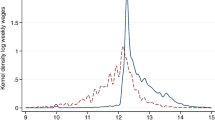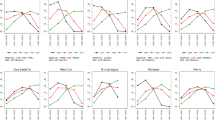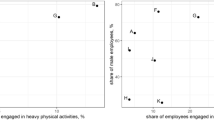Abstract
In this paper we use a methodology for testing for separability of commodity demands from male and female labour supply on a single cross section. In the empirical section of our paper we apply the methodology to a representative micro data base for West Germany. We estimate the corresponding demand systems for nine goods, analyse their economic properties and test the hypothesis that male and female leisure are separable from commodity demand. We reject the hypothesis that goods are separable from male and female time. Moreover, we show the implications of our results for optimal taxation of goods and labour supply.
Similar content being viewed by others
References
Abbott M, Ashenfelter O (1976) Labour Supply, Commodity Demand and the Allocation of Time. Review of Economic Studies 43:389–412
Abbott M, Ashenfelter O (1979) Labour Supply, Commodity Demand and the Allocation of Time — A Correction. Review of Economic Studies 46:567–569
Ashenfelter O (1980) Unemployment as Disequilibrium in a Model of Aggregate Labor Supply. Econometrica 48:547–564
Atkinson AB, Gomulka J, Stern N (1984) Household Expenditure on Tobacco 1970–1980, Discussion Paper No. TIDI/57. London School of Economics, London
Atkinson AB, Gomulka J, Stern N (1989) Spending on Alcohol: Evidence from the Family Expenditure Survey 1970–1983, Discussion Paper No. TIDI/114. London School of Economics, London
Atkinson AB, Stern N, Gomulka J (1981) On Labour Supply and Commodity Demand. Deaton A (ed) Essays in the Theory and Measurement of Consumer Behavior. Cambridge, pp 265–298
Atkinson AB, Stiglitz JE (1976) The Design of Tax Structure: Direct Versus Indirect Taxation. Journal of Public Economics 6:55–75
Atkinson AB, Stiglitz JE (1980) Lectures on Public Economics, London
Barnett W (1979) The Joint Allocation of Leisure and Goods Expenditure. Econometrica 47:539–562
Barnett W (1981) Consumer Demand and Labor Supply, Amsterdam
Barten AP (1969) Maximum Likelihood Estimation of a Complete System of Demand Equations. European Economic Review 1:7–73
Blackorby C, Boyce R, Russel RR (1978) Estimating of Demand Systems Generated by the Gorman Polar Form: A Generalisation of the S-branch Utility Tree. Econometrica 94:800–811
Blackorby C, Primont D, Russell RR (1978) Duality, Separability, and Functional Structure: Theory and Economic Applications, New York
Blomquist N (1985) Labour Supply in a Two-Period Model: The Effect of a Non-Linear Progressive Income Tax. Review of Economic Studies 52:515–524
Blomquist N (1988) Nonlinear Taxes and Labor Supply. European Economic Review 32:1213–1226
Blundell R (1986) Econometric Approaches to the Specification of Life-Cycle Labour Supply and Commodity Demand Behavior. Econometric Reviews 5:83–146
Blundell R, Meghir C (1987) Engel-Curve Estimation with Individual Data. Heijmans RDH, Neudecker H (eds) The Practice of Econometrics: Studies on Demand, Forecasting, Money and Income, Dordrecht, pp 3–14
Blundell R, Meghir C, Symons E, Walker I (1988) Labour Supply Specification and the Empirical Evaluation of Tax Reforms. Journal of Public Economics 36:23–52
Blundell R, Ray R (1984) Testing for Linear Engel Curves and Additively Separable Preferences Using a New Flexible Demand System. Economic Journal 94:800–811
Blundell R, Walker I (1982) Modelling the Joint Determination of Household Labour Supplies and Commodity Demands. Economic Journal 92:351–364
Blundell R, Walker I (1984) A Household Production Specification of Demographic Variables in Demand Analysis. Economic Journal 94:59–68
Blundell R, Walker I (1986) A Life-Cycle Consistent Model of Family Labor Supply Using Cross Section Data. Review of Economic Studies 53:539–558
Browning M, Meghir C (1989) Testing for the Separability of Commodity Demands from Male and Demale Labour Supply, IFS-Working Paper Series No. 89/4. Institute of Fiscal Studies, London
Chiappori PA (1988) Rational Household Labour Supply. Econometrica 49:63–90
Corlett WJ, Hague DC (1953–54) Complementarity and The Excess Burden of Taxation. Review of Economic Studies 21:21–30
Dalton TR, Sadka E (1979) A Many Good Corlett-Hague Tax Rule. Economics Letters 4:169–172
Deaton A (1981a) Optimal Taxes and the Structure of Preferences. Econometrica 49:1245–1260
Deaton A (1981 b) Theoretical and Empirical Approaches to Consumer Demand Under Rationing. Deaton A (ed) Essays in the theory and Measurement of Consumer Behaviour, New York, pp 55–72
Deaton A (1982) Model Selection Procedures, or, Does the Consumption Function Exist? Chow GC, Corsi P (eds) Evaluating the Reliability of Macro-Economic models, New York, pp 43–69
Deaton A (1984) Household Surveys as a Data Base for the Analysis of Optimality and Disequilibrium. The Indian Journal of Statistics 46:228–246
Deaton A (1986) Demand Analysis, Griliches Z, Intriligator MD (ed) Handbook of Econometrics, 3, Amsterdam, pp 1767–1839
Deaton A, Irish M (1984) Statistical Models for Zero Expenditures in Household Budgets. Journal of Public Economics 23:59–80
Deaton A, Muellbauer J (1980) The Economics of Consumer Behaviour. Cambridge
Deaton A, Muellbauer J (1981) Functional Forms for Labour Supply and Commodity Demands with and without Quantity Restrictions. Econometrica 49:1521–1532
Diamond PA, Mirrlees JA (1971) Optimal Taxation and Public Production II: Tax Rules. American Economic Review 61:261–278
Diewert WE (1971) An Application of the Shepard Duality Theorem: A Generalised Leontief Production Function. Journal of Political Economy 79:481–507
Diewert WE (1974) Applications of Duality Theory. Intriligator MD, Kendrick DA (eds) Frontiers of Quantitative Economics. Amsterdam, pp 106–171
van Essen U, Kaiser H, Spahn PB (1988) Verteilungswirkungen der Einkommensteuerreformen 1986–1990. Finanzarchiv 46:56–84
van Essen U, Kassella T (1988) Die Einkommensangaben im Sozio-ökonomischen Panel des Sonderforschungsbereiches 3 und ihre Relevanz für steuerpolitische Simulationen. Reich UP (ed) Sonderhefte zum Allgemeinen Statistischen Archiv, 26, Göttingen, pp 133–166
Hanefeld U (1987) Das Sozio-ökonomische Panel — Grundlagen und Konzeption, Frankfurt/New York
Hausman JA (1979) The Econometrics of Labor Supply on Convex Budget Sets. Economics Letters 3:171–174
Heckman JJ (1976) The Common Structure of Statistical Models of Truncation, Sample Selection Bias and Limited Dependent Variables and a Simple Estimator for Such Models. Annals of Economic and Social Measurement 5:475–492
Heckman JJ (1980) Sample Selection as a Specification Error with an Application to the Estimation of Labor Supply Functions. Smith JP (ed) Female Labor Supply: Theory and Estimation. Princeton, pp 206–248
Jorgenson DW, Lau LJ (1975) The Structure of Consumer Preferences. Annals of Economic and Social Measurement 4:49–101
Judge GG, Griffiths WE, Hill RC, Lütkepohl H, Lee TC (1988) Introduction into the Theory and Practice of Econometrics. New York
Kaiser H (1986) Zur Umsetzung der Optimalsteuertheorie in eine empirische Untersuchungskonzeption — Spezifikation und Schätzmethoden konsistenter Güternachfrage-und Arbeitsangebotsfunktionen auf Basis von Querschnittsinformationen. Sfb 3-Arbeitspapier Nr. 221, Frankfurt/M and Mannheim
Kaiser H (1987) Allokative Effizienz der Verbrauchsbesteuerung — Eine empirische Überprüfung der Optimalsteuertheorie und der Theorie der Mehrbelastung auf Basis der Einkommens- und Verbrauchsstichprobe 1978. Sfb 3-Arbeitspapier Nr. 240, Frankfurt/M and Mannheim
Kaiser H (1989) Die Mehrwertsteuerbelastung der privaten Haushalte in der Bundesrepublik Deutschland. DIW-Vierteljahrsheft zur Wirtschaftsforschung, Heft 1, pp 24–44
Kaiser H (1990a) Konsumnachfrage, Arbeitsangebot und optimale Haushaltsbesteuerung. Frankfurt/M et al.
Kaiser H (1990b) On the Estimation of a Commodity Demand and Labour Supply System for West Germany. TIDI-Discussion Paper No. 144, London School of Economics, STICERD, London
Kaiser H, Spahn PB (1989) On the Efficiency and Distributive Justice of Consumption Taxes — A Study of VAT in West Germany. Journal of Economics 49:199–218
Kaiser H, van Essen U, Spahn PB (1989) Einkommensteuerreform, Arbeitsangebot und ökonomische Wohlfahrt — Eine mikroökonometrische Simulationsstudie für die Bundesrepublik Deutschland. Sfb 3-Arbeitspapier Nr. 277, Frankfurt/M and Mannheim
Kaiser H, Wiegard W, Zimmermann HG (1990) Testing the Reliability of Optimal Tax Calculations. Finanzarchiv 48:77–96
Kassella T (1988) Die Konstruktion eines synthetischen Mikrodatenfiles für steuerpolitische Simulationen. Sfb 3-Arbeitspapier Nr. 266, Frankfurt/M and Mannheim
Kassella T, Hochmuth U (1989) Ein synthetisches Mikrodatenfile des Haushaltssektors für steuerpolitische Simulationen. Sfb 3-Arbeitspapier Nr. 299, Frankfurt/M und Mannheim
Kay J, Keen M, Morris C (1984) Estimating Consumption from Expenditure Data. Journal of Public Economics 23:169–182
Keen M (1986) Zero Expenditures and the Estimation of Engel Curves. Journal of Applied Econometrics 1:277–286
Killingsworth MR (1983) Labor supply. Cambridge
Killingsworth MR, Heckman J (1986) Female Labor Supply. Ashenfelter O, Layard R (eds) Handbook of Labor Economics, 1, Amsterdam, pp 103–204
King MA (1983) Welfare Analysis of Tax Reforms Using Household Data. Journal of Public Economics 21:183–214
Kitterer W (1986) Die Einkommens- und Verbrauchsstichproben des Statistischen Bundesamtes (EVS). Lindner H (ed) Aussagefähigkeit von Einkommensverteilungsrechnungen für die Bundesrepublik Deutschland, Tübingen, pp 25–102
Kooreman P, Kapteyn A (1985) Estimation of a Game Theoretic Model of Household Labour Supply, Mimeo
Lee L-F, Pitt MM (1986) Microeconometric Demand Systems with Binding Nonnegativity Constraints. The Dual Approach. Econometrica 54:1237–1242
Mincer J (1974) Schooling, Experience and Earnings. NBER, New York
Muellbauer J (1981) Linear Aggregation in Neoclassical Labour Supply. Review of Economic Studies 48:21–36
Pencavel J (1986) Labor Supply of Men. Ashenfelter O, Layard R (eds) Handbook of Labor Economics, 1. Amsterdam, pp 3–102
Phlips L (1978) The Demand for Leisure and Money. Econometrica 46:1025–1043
Roth M (1987) Datenhandbuch zur EVS 1978 (DEC 1091 Version). Sfb 3-Dokumentation, Frankfurt/M and Mannheim
Sadka E (1977) A Theorem of Uniform Taxation. Journal of Public Economics 7:387–391
Sandmo A (1974) A Note on the Structure of Optimal Taxation. American Economic Review 64:701–706
Sandmo A (1976) Optimal Taxation — An Introduction into the Literature. Journal of Public Economics 6:37–54
Spahn PB, Galler H, Kaiser H, Kassella T, Merz J (1992) Mikrosimulation in der Steuerpolitik, Heidelberg
Statistisches Bundesamt (ed) (1982) Einkommens- und Verbrauchsstichprobe 1978: Einnahmen und Ausgaben privater Haushalte. Wirtschaftsrechnungen, Fachserie 15, Heft 4, Stuttgart
Statistisches Bundesamt (ed) (1983) Einkommens- und Verbrauchsstichprobe 1978: Aufwendungen privater Haushalte für den Privaten Verbrauch. Wirtschaftsrechnungen, Fachserie 15, Heft 5, Stuttgart
Tobin J (1958) Estimation of Relationships for Limited Dependent Variables. Econometrica 26:24–36
Wales TJ, Woodland AD (1983) Estimation of Consumer Demand Systems with Binding Non-Negativity Constraints. Journal of Econometrics 21:263–285
Zellner A (1962) An Efficient Method of Estimation Seemingly Unrelated Regressions and Tests for Aggregation Bias. Journal of the American Statistical Association 57:348–368
Author information
Authors and Affiliations
Rights and permissions
About this article
Cite this article
Kaiser, H. Testing for separability between commodity demand and labour supply in West Germany. Empirical Economics 18, 21–56 (1993). https://doi.org/10.1007/BF01238878
Received:
Revised:
Issue Date:
DOI: https://doi.org/10.1007/BF01238878




